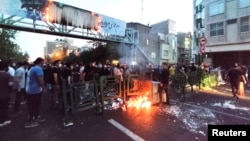Forty-one journalists have been confirmed detained by Iran since protests broke out last month over the death of a woman in the custody of the country's so-called morality police.
Mahsa Amini, 22, a Kurdish woman, was arrested in September for improperly wearing her hijab. She died three days after her arrest. Iran has violently suppressed the protests that followed, and the New York-based Committee to Protect Journalists has documented that as of Wednesday, 41 journalists have been detained. A handful were later released on bail. Most are accused of taking part in the protests they were covering.
But CPJ and other journalists' rights organizations remain concerned for those behind bars, including journalists detained in Tehran’s Evin Prison.
Four journalists believed held in Evin are still unaccounted for after a fire at the facility on Saturday, according to the International Federation of Journalists.
IFJ reported it had identified at least 10 journalists in the prison, including some detained in relation to the protests. Of those, six contacted family to say they were safe. But as of Monday, the families of four others had heard nothing since the fire.
“We are very concerned about the fate of our colleagues in Evin and remind the Iranian authorities that they are responsible for the lives of journalists in prison,” IFJ general secretary Anthony Bellanger said in a statement.
Bellanger called for the “release of all journalists who are unfairly detained in Evin and other prisons in Iran for doing their job.”
One of the latest arrests was that of Mandana Sadeghi, a freelancer detained Tuesday alongside her husband in the city of Abadan.
Around half of the media workers detained for coverage of the protests are female, according to the Coalition for Women in Journalism.
CFWIJ has confirmed at least 20 cases of female journalists being detained across Iran since the protests broke out.
“In a country where women in the media are in the minority, this is a significant number, and we feel the crackdown on women journalists is particularly linked to their gender and reporting,” Kiran Nazish, CFWIJ’s founding director, told VOA in an email.
“These arrests continue, despite the fact that most journalists (and activists) are also in hiding,” Nazish said.
With access to the internet blocked in many parts of Iran, getting information out and providing safety advice to those inside is difficult.
CFWIJ said that while some of the journalists detained are able to speak with their families or lawyers, most have been unable to do so. Additionally, family and lawyers seeking information are often provided with incorrect information from authorities, Nazish said.
“This has been so consistent that most people we are in touch with think this is being done deliberately to misguide families and cause further distress,” Nazish said.
Those inside Iran have said the arrests, threats and communication blocks being used to “intimidate journalists, activists and dissenters are all a form of 'torture' to intimidate those demanding free expression, and keep them in limbo,” she added.
VOA requested a comment from Iran’s mission to the United Nations but has not received a response.
Digital rights groups, including Access Now, have condemned Tehran over its restrictions on internet access and persecution of tech experts.
“In an attempt to crush the popular uprising and further restrict internet activity and information flows, Iranian authorities are escalating their violent crackdown on people across Iran, and are now targeting internet experts and technologists,” the nonprofit organization said in a statement.
Even before the mass arrests of media and activists, Iran ranked among the 10 worst countries for press freedom.
Media watchdog Reporters Without Borders (RSF) said information comes mainly from news outlets operating outside Iran. The few independent journalists in Iran face persecution in the form of “arbitrary arrests and very heavy sentences,” according to RSF research.
Iran currently ranks 178th out of 180 countries, where 1 has the best media environment, according to RSF’s Press Freedom Index.
The international rights community has called on the U.N. Human Rights Council to take immediate action on Iran.
In a joint statement Monday, Human Rights Watch and dozens of other rights organizations said that since September, more than 1,000 “protesters, human rights defenders, civil society activists, journalists, university students and schoolchildren have been arbitrarily arrested and detained, some already charged with ‘acting against national security.’ ”
U.N. human rights officials have said Iran’s violent response to protests and the reports of arbitrary arrests and killings are alarming.
The rights office said Iran must halt the unnecessary and disproportionate use of force against protesters and release immediately all those detained arbitrarily.
Relatives of those in custody are left waiting for information, Nazish said.
“A few families of journalists have been told they will be released soon, but weeks have gone by without release or clear information about how they are treated inside the prison,” she told VOA.
